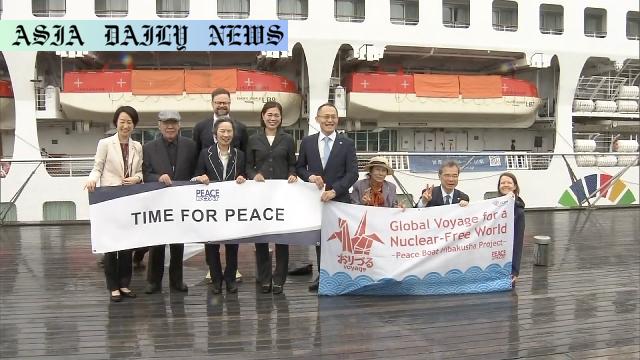Peace Boat: Survivors of Hiroshima and Nagasaki embark on a global voyage to call for nuclear disarmament after 80 years of WWII.

Introduction: The Peace Boat’s Mission
The Peace Boat, a symbol of hope and advocacy for global peace, set sail from Yokohama, Japan, addressing one of the gravest threats to humanity—nuclear weapons. Operated by a Japan-based international NGO, the boat embarked on its meaningful journey to 18 countries, including the United States and various European destinations. This voyage, occurring 80 years after the conclusion of World War II, is meant to amplify the voices of Hiroshima and Nagasaki atomic bomb survivors, ensuring their plea for a nuclear-free world reaches across nations and generations.
The Stories of Hiroshima and Nagasaki Survivors
Among the brave participants is 84-year-old Ito Masao from Hiroshima. Standing at the port of Yokohama, Masao expressed a growing global concern—nuclear weapons used as threats. Reflecting deeply, he articulated a personal sense of duty to warn the world against the perils of nuclear conflict. Similarly, 81-year-old Kuramori Terumi of Nagasaki emphasized the urgency for action, as the population of bomb survivors continues to dwindle. Kuramori hopes to pass on the powerful narratives of resilience, tragedy, and unity while inspiring younger generations to take up the mantle for peace.
Global Influence Through Interaction
Throughout its voyage, the Peace Boat facilitates discussions at its various ports of call. Survivors will engage with local communities, recounting their personal ordeals while advocating for peaceful anti-nuclear resolutions. This communication offers not just firsthand testimony but also a call to collective awareness. Accompanying the survivors is an onboard exhibit highlighting the endeavors of Nihon Hidankyo, the organization representing the community of atomic bomb survivors and recent Nobel Peace Prize laureates. The exhibit educates and inspires, adding a tangible layer to their global mission.
Encouraging Dialogue and Continuing Hope
One significant aspect of the Peace Boat journey is encouraging dialogue. By sparking conversations both online and offline, the NGO seeks to spread awareness and push for global policy changes. The testimonies, coupled with the thought-provoking exhibits, serve as tools for fostering understanding and empathy. As international communities engage with these survivors, there is an undeniable potential for bridging gaps in perception, moving towards shared global commitments to nuclear disarmament and peace.
A Call to Action
The Peace Boat voyage is no ordinary journey—it’s a wake-up call for humanity. As these survivors undertake what might be one of their last opportunities to share their experiences firsthand, they pass the torch of responsibility to the next generation. The world must listen, embrace their message, and act collectively to forge a nuclear-free path. Their stories are reminders of resilience and the pressing need for relentless advocacy against nuclear arms in a time where weapons of mass destruction still threaten peace and security globally.
The Legacy of Peace
As the Peace Boat carries hope across international waters, it also signifies a continued fight for justice, unity, and remembrance. The survivors’ journey on this ship encapsulates the broader goal of ensuring history’s lessons are neither forgotten nor repeated. While the voyage lasts only three months, its ripple effects have the power to catalyze transformative dialogues worldwide. From one generation to the next, their voices echo with purpose and a shared vision for a safer, compassionate future.
Commentary
The Inspiring Efforts of the Peace Boat
What the Peace Boat represents is something truly extraordinary. It isn’t just a ship—it’s a vessel of hope navigating through the turbulent seas of global uncertainty. The voyage symbolizes much more than the physical journey across 18 countries; it showcases humanity’s resilience and collective aspirations for a future free of nuclear conflict. At its heart are the poignant and deeply emotional testimonies of survivors, individuals who lived through one of the most horrific episodes in human history. Their determination to ensure these stories are shared globally leaves a lasting impact on all of us.
The Courage of Hiroshima and Nagasaki Survivors
What strikes me most about figures like Ito Masao and Kuramori Terumi is their unyielding courage. After surviving unimaginable devastation, they have dedicated their lives to tirelessly advocating for a nuclear-free world. At their age, embarking on such a long and physically taxing voyage shows not only their steadfast commitment but also how seriously they take their mission. These survivors remind us that personal stories of resilience and hope carry far more weight than abstract statistics or impersonal narratives. They place a human face on the horrors of nuclear violence, urging us not to remain indifferent.
A Universal Message for the Next Generation
What makes the Peace Boat stand out is its ability to connect past, present, and future generations. It bridges gaps and initiates dialogues that are sorely needed at a time when nuclear threats still loom. The onboard activities, exhibits, and intimate interactions enrich the experience for both survivors and participants, fostering an exchange of ideas that transcends borders. This initiative beautifully exemplifies how grassroots movements can spark profound global waves of awareness. The Peace Boat may physically travel through a sea of tumult, but the ideas it carries will continue to grow, reaching future shores with a message of nonviolence, hope, and unity.
Conclusion: A Responsibility Shared by All
In reflecting on the significance of the Peace Boat, one cannot help but feel both inspired and compelled to act. As these survivors tirelessly campaign for nuclear disarmament, they remind us of our collective responsibility to safeguard peace for future generations. Their courage and commitment should not only be celebrated but also supported. The Peace Boat is a clarion call for action—a striking reminder that while these survivors may one day no longer be with us, their message must never fade. Let us honor their legacy by striving for a world free from the shadow of nuclear weapons.


